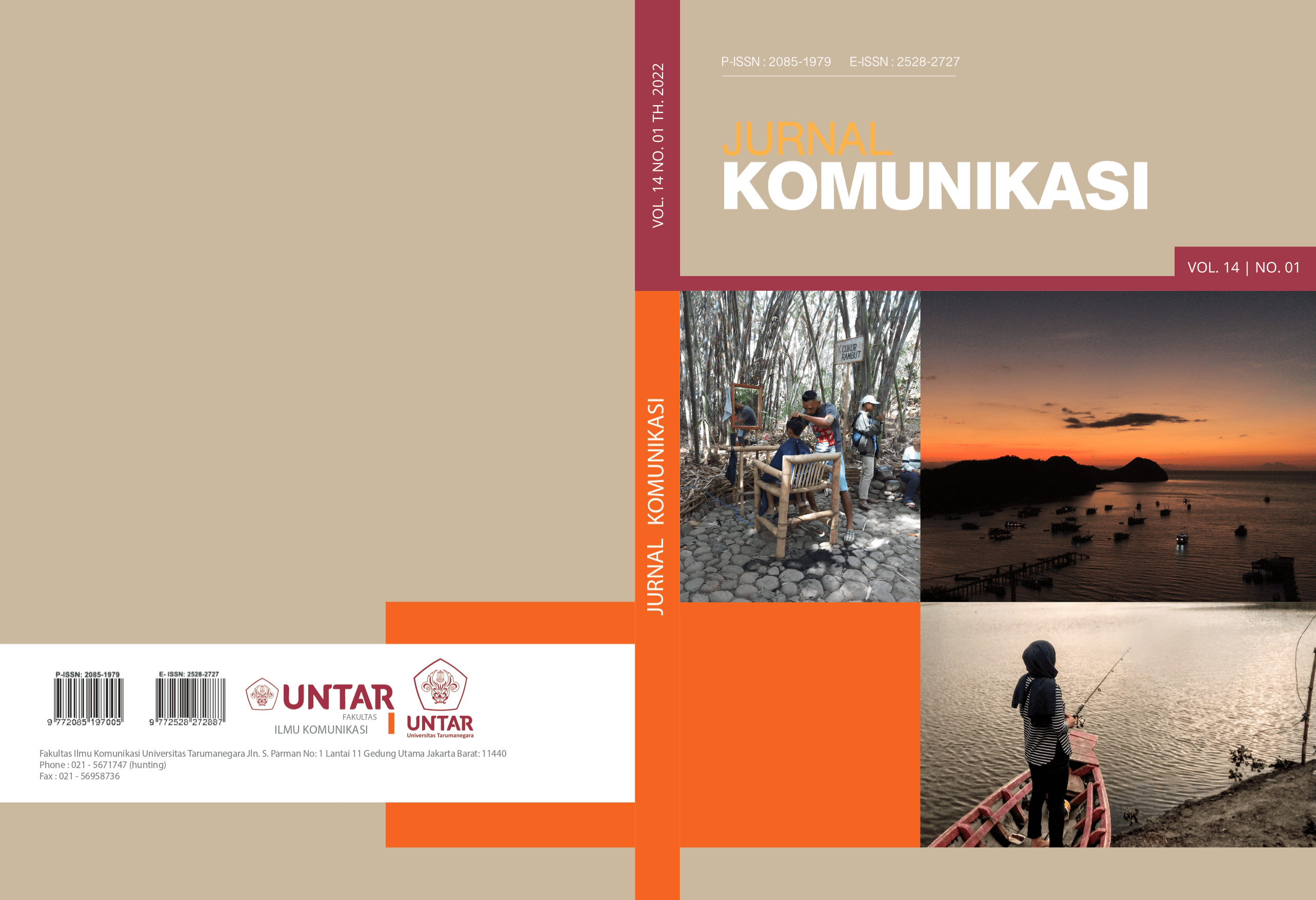Study of Dual Brand in Indonesia Tourism Communication
Main Article Content
Abstract
One of the main parts of a country's tourism communication is the tourism destination brand. The Indonesian tourism destination brand itself has changed several times since 2008. At that time, the brand used was Visit Indonesia 2008, then the following year it changed to Visit Indonesia 2009. Then in 2010 until 2021, Indonesia uses two brands at once, namely Wonderful Indonesia and Pesona Indonesia, even though the Indonesian tourism destination in question is one, namely Indonesia's destination. In fact, the use of these two brands has not been able to show a positive performance in bringing in tourists or making Indonesian tourism destinations famous and remembered by potential tourists. Therefore, we need a study on the existence of this dual brand, which is the purpose of this scientific article The subject of this study is the Indonesian tourism brand, Wonderful Indonesia, while the object studied is the duality in the use of the brand. This study was made using qualitative methods, specifically by using literature review. The method of data collection is documentation. This study uses a narrative method in its discussion. From this study, it can be explained that the brand personality of the Indonesian tourism destination brand is still weak. This is mainly due to the dual brands Wonderful Indonesia and Pesona Indonesia which have two different meanings and have not been able to represent tourist destination areas in Indonesia. In the end, this makes brand awareness, brand equity and brand loyalty are not formed. Therefore, it would be better if only one tourism destination brand can be formulated. The brand should represent various tourist destination areas and can be used consistently for a long time.
Article Details
Section

This work is licensed under a Creative Commons Attribution-ShareAlike 4.0 International License.
This work is licensed under a Jurnal Komunikasi Creative Commons Attribution-ShareAlike 4.0 International License.How to Cite
References
ASEAN Statistics Division. (2020). ASEAN Visitor Arrivals Dashboard. ASEANstatsDataPortal. https://data.aseanstats.org/dashboard/tourism
Badan Pusat Statistik. (2020a). Jumlah Perjalanan Wisatawan Nusantara (Orang), 2017-2019. https://www.bps.go.id/indicator/16/1189/1/jumlah-perjalanan-wisatawan-nusantara.html
Badan Pusat Statistik. (2020b). Kunjungan Wisatawan Mancanegara per bulan Menurut Kebangsaan (Kunjungan), 2019. https://www.bps.go.id/indicator/16/1470/3/kunjungan-wisatawan-mancanegara-per-bulan-menurut-kebangsaan.html
Barliana, F. R. (2017). Program Wonderful Indonesia Dalam Menarik Wisatawan Jepang. Global Political Studies Journal, 1(1), 51–62.
Bouchon, F. A. L. (2014). Truly Asia and Global City? Branding Strategies and Contested Identities In Kuala Lumpur. Place Branding and Public Diplomacy, 10(1), 6–18. https://doi.org/10.1057/pb.2013.21
Bungin, B. (2015). Komunikasi Pariwisata Pemasaran dan Brand Destinasi. Prenadamedia Group.
Centre for ASEAN Public Relations Studies. (2019). ASEAN Travel Infographics: Fact & Recommendation (Y. R. Prasetyawati, C. Keliat, & C. Alverina (eds.)).
Lembaga Penelitian dan Pengabdian kepada Masyarakat London School of Public Relations Jakarta. http://setnas-asean.id/site/uploads/document/book/5d536eb1ec22f-asean-travel-infographics-ebook-12-agustus-2019.pdf
Direktorat Jenderal Anggaran. (2016). Efektivitas Alokasi Anggaran Kementerian Pariwisata terhadap Kunjungan Wisatawan Mancanegara dan Wisatawan Nusantara. http://www.anggaran.kemenkeu.go.id/in/post/efektivitas-alokasi-anggaran-kementerian-pariwisata-terhadap-kunjungan-wisatawan-mancanegara-dan-wisatawan-nusantara
Dzulyana, M. A., Irawan, E. P., & Saragih, N. (2019). Semiotic Analysis of the Message of Meaning on Pesona Indoneisa Advertisement of Pesona Indonesia 2017 Destination Version. International Journal of Innovative Science and Research Technology, 4(10), 476–484. www.ijisrt.com476
Febrina, D. (2018a). Kesepakatan Terhadap Brand Wonderful Indonesia: Kajian Terhadap Pelancong Dan Pegawai Pemerintah. Jurnal Ranah Komunikasi (JRK), 2(2), 71–80. https://doi.org/10.25077/rk.2.2.71-80.2018
Febrina, D. (2018b). Persepsi Wisatawan Mancanegara Terhadap Brand Pariwisata Wonderful Indonesia. WACANA, Jurnal Ilmiah Ilmu Komunikasi, 17(1), 72–81. https://doi.org/10.32509/wacana.v17i1.515
Hart, C. (2018). Doing a Literature Review, Releasing the Social Science Research Imagination. SAGE Publications Ltd.
Idriasih, G. (2016). Diplomasi Indonesia Melalui Kampanye Wonderful Indonesia Dalam Meningkatkan Pariwisata Indonesia di Dunia Internasional Tahun 2011-2015. JOM FISIP, 3(1), 1–15.
Keputusan Menteri Pariwisata Republik Indonesia Tentang Logo Wonderful Indonesia dan Logo Pesona Indonesia, Pub. L. No. KM.142/UM.001/MP/2018, 1 (2018). https://www.kemenparekraf.go.id/asset_admin/assets/uploads/media/pdf/media_1596538172_SK_Logo_WI_dan_PI.pdf
Nam, J., Ekinci, Y., & Whyatt, G. (2011). Brand Equity, Brand Loyalty and Consumer Satisfaction. Annals of Tourism Research, 38(3), 1009–1030. https://doi.org/10.1016/j.annals.2011.01.015
Novianti, E., & Wulung, S. R. P. (2020). Implementasi Komunikasi Daring dalam Menunjang Jawa Barat sebagai Destinasi Pariwisata Cerdas. Jurnal Komunikasi, 12(1), 53–63. https://doi.org/http://dx.doi.org/10.24912/jk.v12i1.6971
Seimiene, E., & Kamarauskaite, E. (2014). Effect of brand elements on brand personality perception. Procedia - Social and Behavioral Sciences, 156(April), 429–434. https://doi.org/10.1016/j.sbspro.2014.11.216
Setyanto, Y., & Winduwati, S. (2017). Diseminasi Informasi Terkait Pariwisata Berwawasan Lingkungan dan Budaya Guna Meningkatkan Daya Tarik Wisatawan (Studi pada Dinas Pariwisata Provinsi Nusa Tenggara Barat). Jurnal Komunikasi, 9(2), 164–175.
Situmeang, I. V. O., & Sugianto, A. S. (2017). The Identification of Persuasive Message Campaign “Wonderful Indonesia 2015.” Jurnal ASPIKOM, 3(3), 520–538. https://doi.org/10.24329/aspikom.v3i3.106
Tasci, A. D. A., & Guillet, B. D. (2011). It affects, it affects not: A quasi-experiment on the transfer effect of co-branding on consumer-based brand equity of hospitality products. International Journal of Hospitality Management, 30(4), 774–782. https://doi.org/10.1016/j.ijhm.2010.12.009
Tran, X., Dauchez, C., & Szemik, A.-M. (2013). Hotel Brand Personality and Brand Quality. Journal of Vacation Marketing, 19(4), 329–341. https://doi.org/10.1177/1356766713481218
Tunggala, S., & Saadjad, K. A. (2019). Strategi Komunikasi pada Dinas Kebudayaan dan Pariwisata dalam Mempromosikan Objek Wisata Kabupaten Banggai. Jurnal Komunikasi, 11(2), 197. https://doi.org/10.24912/jk.v11i2.2714
Ukpabi, D. C., & Karjaluoto, H. (2017). Consumers’ Acceptance Of Information and Communications Technology in Tourism: A Review. Telematics and Informatics, 34(5), 618–644. https://doi.org/10.1016/j.tele.2016.12.002
Yuristiadhi, G., & Sari, S. D. L. (2018). Strategi Branding Pariwisata Indonesia Untuk Pemasaran Mancanegara. ETTISAL Journal of Communication, 2(2), 31–41. https://doi.org/10.21111/ettisal.v2i2.1265

